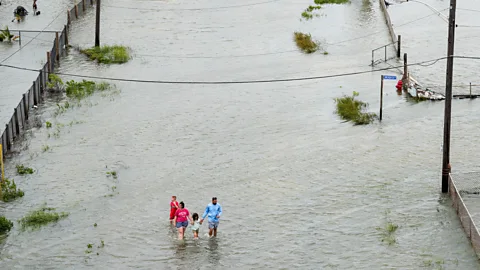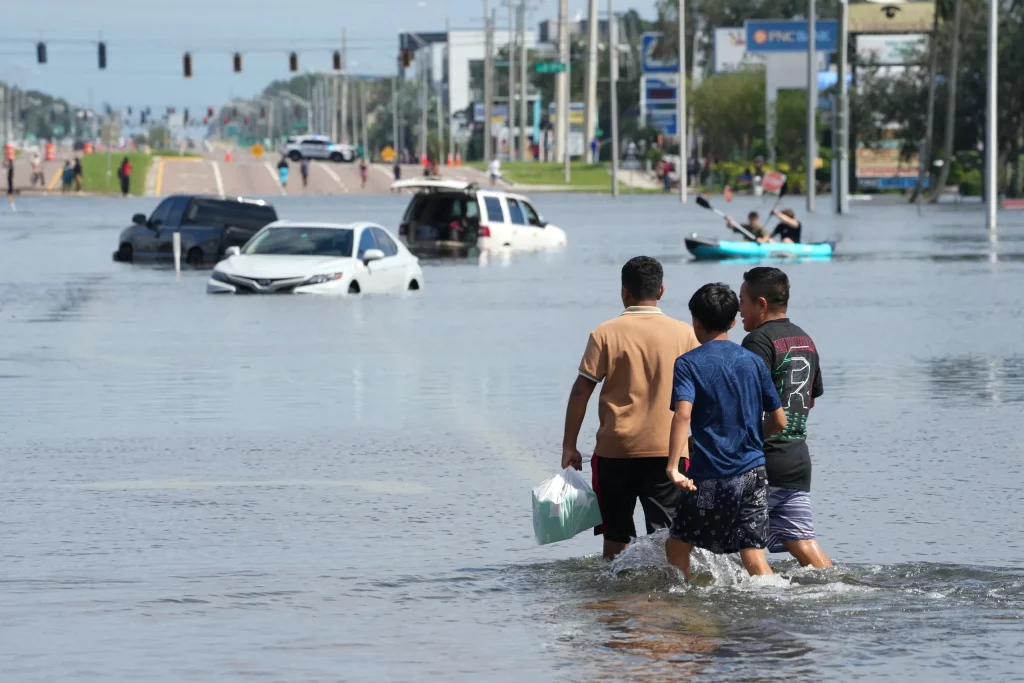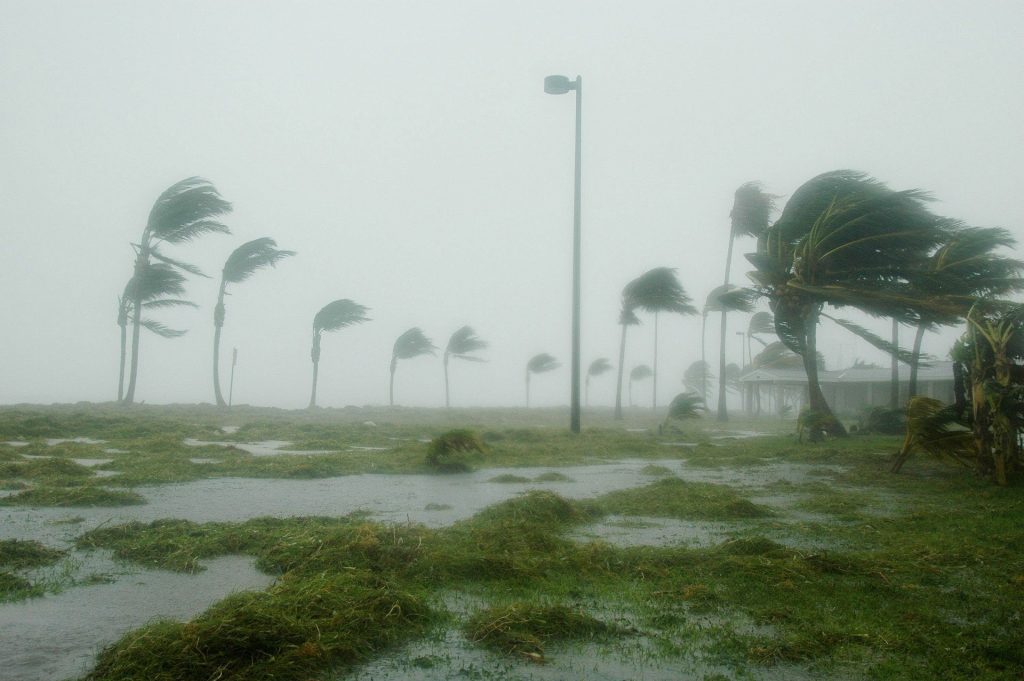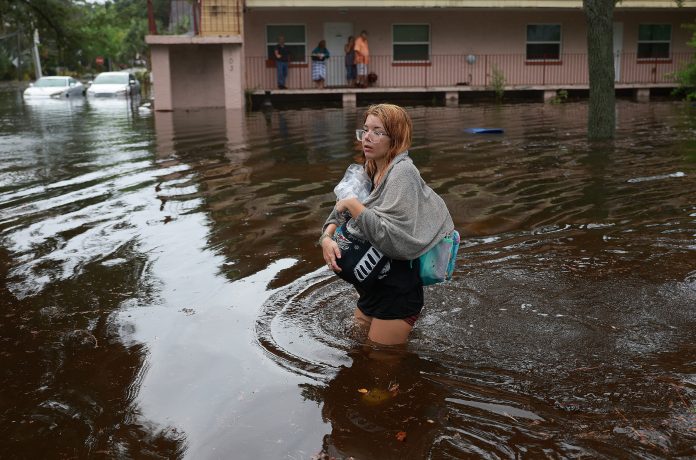Unseen Threats: The Surge of Infectious Diseases After Hurricanes.
When hurricanes wreak havoc, the immediate danger to life and infrastructure is evident. Yet lurking in the aftermath of these powerful storms are invisible threats: infectious diseases. With rising ocean temperatures contributing to more frequent and intense tropical storms, understanding how hurricanes spread diseases is vital for public health preparedness.
For over seven years, scientists like Naresh Kumar from the University of Miami have studied hurricanes, focusing not only on the destruction but on the diseases that follow. His research examines hurricanes like Maria, Irma, Michael, Dorian, and, most recently, Hurricanes Helene and Milton. While infrastructure losses are often widely reported, the silent spread of infectious diseases in post-hurricane conditions carries significant long-term consequences.
The recent devastation brought by Hurricane Helene in Florida serves as a powerful reminder of the hidden dangers that come with floodwaters. As the hurricane surged through, it inundated communities, causing flooding and landslides that resulted in contamination. Florida health authorities quickly released warnings about the likelihood of an increase in Vibrio vulnificus, a bacteria that thrives in warm water and can lead to life-threatening infections. The bacteria has already infected 77 people in Florida this year, resulting in 15 deaths — the highest reported cases in the last decade.
Vibrio vulnificus is a severe threat, with symptoms that range from gastrointestinal distress to serious skin and soft tissue infections that can necessitate amputations. The aftermath of Hurricane Ian in 2022 also saw an unusual increase in Vibrio infections in Florida, underscoring how floods from hurricanes create ideal conditions for such bacteria. “Vibrio prefers warmer waters, and hurricanes typically occur when water is warmest,” explains John Drake, director of the Center for the Ecology of Infectious Diseases at the University of Georgia. Hurricanes can push Vibrio bacteria further inland, exposing more people to this pathogen.

Each year, tropical cyclones impact 150 million people worldwide, with most victims living in coastal areas. These storms, which include hurricanes, typhoons, and cyclones, cause enormous flooding, destroy water and sewage infrastructure, and facilitate the spread of infectious diseases.
When a hurricane causes a storm surge, seawater raises the water level, sometimes by up to 6 meters (about 19 feet), which overwhelms sewage systems and allows pathogens to enter the water supply. Animal waste from farms, mixed with floodwaters, spreads microbes that would not typically reach residential areas. In some cases, microbes travel hundreds of miles through rivers, carrying diseases from one community to another.
“Even with ordinary rainfall, there’s a certain level of microbial contamination,” explains Kumar. The Healthy Beaches program in Florida monitors such contamination, showing how bacterial levels spike after significant rainfall.
While Vibrio infections often make headlines, they represent only one part of the disease burden following hurricanes. Flooding often leads to gastrointestinal illnesses, which can spread quickly due to contaminated food and water sources. In the aftermath of hurricanes, public health workers have observed outbreaks of diseases typically associated with extreme poverty, including cholera and typhoid.
Cholera, a bacterial infection that causes severe dehydration, has surfaced in U.S. coastal communities after hurricanes, while other tropical cyclones have led to similar outbreaks globally. For example, research has found that intestinal diseases rose in Taiwan after typhoons, increasing the risk of sepsis in affected populations.
Drake explains that gastrointestinal diseases spread after hurricanes because waterborne pathogens become prevalent in floodwater. Following hurricanes, pathogens in animal waste, farm fertilizers, and human sewage infiltrate water sources, often overwhelming treatment systems. The powerful winds associated with hurricanes can also transport airborne pathogens far from the storm’s path.

Once the initial flooding subsides, mosquitoes quickly take advantage of the standing water left behind. Pools of stagnant water become breeding grounds for these insects, which spread diseases like West Nile virus, dengue, Zika, and chikungunya. In the wake of Hurricane Katrina, Louisiana and Mississippi reported spikes in West Nile cases, while Hurricane Fiona in Puerto Rico was followed by a rise in dengue infections.
Interestingly, as hurricanes move north, so do the diseases they carry. Canada, which historically has not had malaria as a public health issue, has seen a few cases near the eastern border following recent hurricanes. Kimberly Davis, an associate professor at Johns Hopkins Bloomberg School of Public Health, explains that the shift in climate and standing water after hurricanes can alter local insect populations, leading to an increased number of disease-carrying mosquitoes.
“After a hurricane, we often see an increase in the incidence of viral diseases carried by mosquitoes,” says Davis. This effect is magnified by changing environmental conditions, which can make some previously unaffected areas more conducive to mosquito breeding.
Beyond waterborne and mosquito-borne diseases, hurricanes also create ideal conditions for airborne diseases. Mold spores and fungi flourish in damp, humid environments, like those created by indoor flooding. For individuals returning to homes damaged by hurricanes, exposure to mold can lead to respiratory problems, worsening conditions like asthma and even triggering new allergic reactions.
Kumar has found that chronic respiratory conditions like asthma increase in the months following hurricanes, with many patients developing new allergies after exposure to household mold. Standing water evaporates and carries mold spores into the air, which then circulate in homes and public spaces.
After Hurricanes Rita and Katrina in Louisiana, researchers discovered increased levels of airborne fungi like Penicillium and Aspergillus, which can exacerbate allergies and lead to respiratory infections. This risk is amplified by damaged ventilation systems in homes, where even minor leaks can facilitate mold growth.
According to Kumar, neglected health risks like mold exposure are sometimes life-threatening. “Some people develop lifelong respiratory problems after a hurricane,” he notes. “They might never fully recover from exposure to severe concentrations of mold.”
A further complication in managing infectious diseases post-hurricane is the disruption to healthcare facilities. Flooding often limits access to essential medical services, with hospitals and pharmacies forced to close due to power outages and water damage. This was evident in the wake of Hurricane Katrina, when major hospitals in New Orleans were surrounded by floodwater and remained closed for months.
Kumar emphasizes that healthcare services need to extend their reach in the aftermath of hurricanes to ensure that communities in need receive timely treatment. Limited access to medical attention can lead to untreated infections, exacerbating public health crises.
For vulnerable populations, such as the elderly, children, and people living in poverty, the risks are even greater. “Infectious diseases tend to disproportionately affect those in poverty,” explains Gina Charnley, a global health researcher at Imperial College London. “People who have the means to evacuate are less likely to get sick, while those who can’t escape the area face the highest risk of disease.”
As the frequency and intensity of hurricanes increase, preparing for disease outbreaks in affected areas is becoming essential. Kumar and Davis advocate for mobile healthcare delivery systems at every shelter and evacuation center, as well as mobile clinics in flood-prone areas. Immediate access to medical attention can reduce the likelihood of infection and save lives.
Local governments are also responding by updating infrastructure. For example, after Hurricane Floyd in 1999 caused swine lagoons to rupture and contaminate the water supply in North Carolina, new regulations were implemented to prevent similar incidents in the future. Some municipalities with large sewage treatment facilities are adopting emergency contingency plans to prepare for hurricanes, recognizing the importance of controlling the spread of disease.
Education is another key factor. Public health agencies, including the CDC, release guidelines for communities in hurricane-prone regions to prevent disease transmission. They recommend avoiding contact with floodwater, boiling drinking water, wearing protective clothing, and seeking prompt medical attention for any cuts or wounds. By understanding the risks, individuals can take steps to protect themselves and limit the spread of infections.
The influence of climate change on hurricane frequency and intensity highlights an urgent need for ongoing public health research and adaptation. Rising sea levels, warmer ocean temperatures, and changes in global wind patterns all contribute to the formation of stronger hurricanes, which in turn increases the likelihood of infectious disease outbreaks. Coastal communities must adapt to these new realities to ensure public safety and health.
Investments in resilient infrastructure, like reinforced sewage systems and storm-resistant buildings, can reduce exposure to contaminated water. Emergency preparedness plans that incorporate mobile healthcare units and disease monitoring systems will also be critical to minimizing disease outbreaks in future storm events.

Kumar believes that increasing awareness about these risks can have a meaningful impact on public health. “By making people aware of the risks associated with disease and hurricanes, we can take steps to reduce those risks,” he says.
As hurricanes become more intense and frequent due to climate change, infectious diseases are becoming an ever-greater concern for storm-affected areas. The dangers of contaminated floodwaters, mosquito-borne diseases, airborne mold spores, and limited healthcare access converge in the wake of hurricanes, posing a complex challenge for public health authorities. By investing in resilient infrastructure, creating mobile healthcare responses, and increasing public awareness, communities can take proactive measures to safeguard public health against these hidden threats.
Ensuring that infectious diseases are addressed alongside the immediate risks of hurricanes can save lives and improve long-term health outcomes for vulnerable populations. The future of hurricane preparedness must therefore encompass strategies for preventing, identifying, and treating infectious diseases.
On October 9, 2024, Hurricane Milton tore through Florida’s west coast, leaving a devastating mark on the Sunshine State. The powerful Category 3 storm made landfall near Siesta Key with sustained winds of 120 mph, bringing with it storm surges, heavy rainfall, and severe flooding. As the state struggles to recover, the impacts of Milton are a sobering reminder of the challenges communities face when rebuilding after such destructive storms.
Hurricane Milton;
On October 9, 2024, Hurricane Milton, a devastating Category 3 storm, made landfall on Florida’s west coast, unleashing widespread destruction. The storm brought winds of 120 mph and left a trail of chaos in its wake, from catastrophic flooding and massive storm surges to tornadoes and extensive power outages. For millions of Floridians, the storm has been a harsh reminder of nature’s power, compounded by the recent devastation of Hurricane Helene. Milton’s impact tragically took at least 11 lives and compounded the toll from Helene, which claimed the lives of 240 people across Florida and other Southeastern states.
As Florida gradually returns to normalcy, ongoing recovery efforts emphasize community resilience, partnerships, and the critical support provided by relief organizations and local churches. Here, we take an in-depth look at the response to Hurricane Milton and the collaborative work underway to support Floridians on their journey to recovery.
The Destructive Force of Hurricane Milton
Hurricane Milton struck the Siesta Key area on Florida’s west coast with ferocity, bringing a powerful storm surge that inundated coastal areas and caused severe flooding across inland communities. Within hours, Milton had left entire neighborhoods underwater, torn apart businesses, and uprooted lives. Floodwaters reached unprecedented levels, trapping residents and leaving emergency response teams scrambling to reach those in need.
In addition to the flooding, widespread tornado activity triggered by the storm tore through several counties, causing severe structural damage and uprooting trees that blocked major roadways. As Milton pushed inland, heavy rains continued to lash the state, leading to flash flooding across vulnerable areas. Thousands of homes were submerged, and streets were filled with debris, making evacuation and rescue operations even more difficult.
The storm also led to extensive power outages, impacting millions of residents. By October 16, 2024, utility companies had restored power to approximately 93% of the homes and businesses that lost service, a feat made possible by the dedication of emergency crews and the support of volunteers who cleared roadways and provided logistical aid. However, some hard-hit areas remain without electricity, which poses a continuous challenge as residents in these neighborhoods work to clean and rebuild.
The lack of power compounded the difficulty for residents trying to communicate with family members and access emergency services. Telecommunications infrastructure was damaged, making phone calls and internet access spotty in affected areas. Utility and telecommunications companies are working around the clock to restore services to every corner of the state, but the scale of the damage means some areas will likely remain without power or stable communication services for some time.
The reopening of gas stations and schools is a small but significant step toward restoring normalcy. Many gas stations across the state have reopened, providing much-needed fuel for residents and emergency responders. Students are preparing to return to school, signaling a return to routine, even though many students have been affected by both Milton and Helene’s disruptions. School administrators and local officials are working to ensure that students can resume learning in a safe environment, despite the damage that some school buildings have sustained.
Local businesses, too, are beginning the recovery process, with some able to reopen their doors to the public. However, countless others face a long road to recovery, as flooding and wind damage have left many storefronts and offices uninhabitable. The economic impact of Hurricane Milton will likely reverberate throughout Florida’s economy, particularly in areas heavily reliant on tourism, which may see a slow season as the state rebuilds.
Even before Hurricane Milton formed in the Gulf of Mexico, relief organizations were on the ground aiding survivors of Hurricane Helene across Florida, Georgia, and the Carolinas. The swift and coordinated response to Milton has been possible in part due to the efforts of charitable organizations and local churches, whose partnerships have allowed essential relief supplies to reach impacted areas quickly.
To respond to Milton, relief teams delivered 12 tractor-trailers loaded with supplies to support affected families. These shipments included essential items such as baby products, cleaning kits, personal care items, food, and water, which were distributed through 20 church partnerships. Thanks to the generosity of donors and these partnerships, relief efforts have already served over 39,600 people across the impacted states, providing crucial support for families who lost everything to the storm.
Local churches have played a significant role, not only in distributing supplies but also in offering shelter, food, and comfort to those in need. The support from these community institutions has been invaluable, creating a safety net for those who are struggling in the wake of the storm. For many residents, the compassion and aid provided by churches and local charities have made a world of difference, offering a sense of hope and community amid the devastation.
While immediate relief is critical, long-term recovery for Florida will require substantial effort to rebuild infrastructure, restore damaged homes, and bolster resilience against future storms. Flooded streets, homes in ruins, and businesses struggling to reopen highlight the extensive damage caused by Milton and the immense need for recovery assistance.
State and federal agencies are working alongside local authorities to assess the full extent of the damage. Funds are being allocated to help affected areas rebuild, but it’s clear that the scale of the recovery effort will require not only government support but also sustained assistance from relief organizations, businesses, and volunteers. Critical infrastructure, including roads, bridges, and electrical grids, will need to be reinforced and adapted to withstand future storms.
Strengthening Florida’s Preparedness for Future Hurricanes;
As climate change intensifies, hurricanes like Milton and Helene are expected to become more frequent and powerful. The back-to-back hurricanes have underscored the urgent need for preparedness measures that can mitigate the impact of these storms on Florida’s communities. Many advocates are calling for strengthened building codes, improved flood management systems, and more robust emergency response infrastructure.
One of the biggest challenges facing Florida is the need to protect its most vulnerable populations, including low-income families, the elderly, and those with disabilities. During disasters like Hurricane Milton, these groups are often at a higher risk, facing barriers in accessing evacuation routes and emergency services. Relief organizations and local governments are now discussing ways to ensure that future disaster response efforts prioritize these vulnerable communities.
In the wake of Hurricane Milton, Floridians are showing incredible resilience. From local heroes helping neighbors to the countless volunteers who have come from near and far to aid in recovery efforts, the sense of community has been a source of strength for many. Despite the daunting road ahead, the dedication of volunteers, first responders, and local leaders is a testament to Florida’s spirit and determination to rebuild.
For families in Siesta Key and beyond, the journey to recovery may be long, but with continued support from relief organizations, churches, and the community at large, there is hope for a brighter future. Every contribution—from the donation of food and water to the offering of a helping hand—plays a part in helping Florida heal from the impacts of Hurricane Milton. And as the state rebuilds, it does so with a renewed commitment to resilience, preparing for whatever challenges may come next.
As Florida recovers from Hurricane Milton, there is a growing awareness of the need to not only rebuild but to build back stronger. Community leaders, state agencies, and relief organizations are already exploring ways to reinforce infrastructure and protect lives in future storms. The devastating effects of Milton and Helene underscore the importance of preparedness, collaboration, and resilience. For now, Florida’s focus remains on providing support for the families who have lost so much. Through the efforts of local partnerships and the generosity of donors, the state is moving forward—determined to rise above the destruction and emerge stronger than ever.




